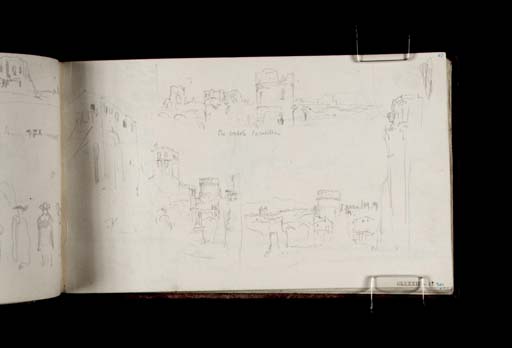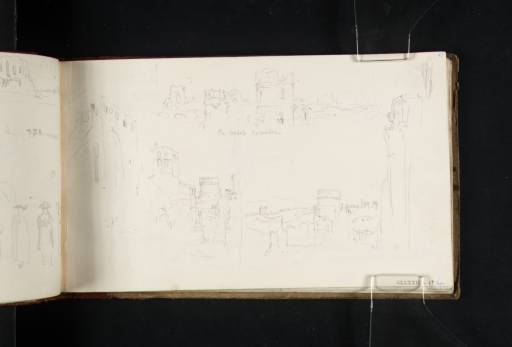Joseph Mallord William Turner The Via Appia Antica, Rome: the Circus of Maxentius; and Two Views Approaching the Tomb of Cecilia Metella 1819
Image 1 of 2
-
 Joseph Mallord William Turner, The Via Appia Antica, Rome: the Circus of Maxentius; and Two Views Approaching the Tomb of Cecilia Metella 1819
Joseph Mallord William Turner, The Via Appia Antica, Rome: the Circus of Maxentius; and Two Views Approaching the Tomb of Cecilia Metella 1819 -
 Joseph Mallord William Turner, The Via Appia Antica, Rome: the Circus of Maxentius; and Two Views Approaching the Tomb of Cecilia Metella 1819 (Enhanced image)Enhanced image
Joseph Mallord William Turner, The Via Appia Antica, Rome: the Circus of Maxentius; and Two Views Approaching the Tomb of Cecilia Metella 1819 (Enhanced image)Enhanced image
Joseph Mallord William Turner,
The Via Appia Antica, Rome: the Circus of Maxentius; and Two Views Approaching the Tomb of Cecilia Metella
1819
Joseph Mallord William Turner 1775–1851
Folio 47 Recto:
The Via Appia Antica, Rome: the Circus of Maxentius; and Two Views Approaching the Tomb of Cecilia Metella 1819
D15384
Turner Bequest CLXXXII 47
Turner Bequest CLXXXII 47
Pencil on white wove paper, 113 x 189 mm
Inscribed by the artist in pencil ‘The Consolo Caracalla’
Inscribed by John Ruskin in blue ink ‘47’ top right and ‘301’ bottom right
Stamped in black ‘CLXXXII 47’ bottom right
Inscribed by John Ruskin in blue ink ‘47’ top right and ‘301’ bottom right
Stamped in black ‘CLXXXII 47’ bottom right
Accepted by the nation as part of the Turner Bequest 1856
References
1909
A.J. Finberg, A Complete Inventory of the Drawings of the Turner Bequest, London 1909, vol.I, p.538, as ‘Circus of Romulus Maxentius, Mole of Cæcilia Metella, &tc.’.
2008
Nicola Moorby, ‘Un tesoro italiano: i taccuini di Turner’, in James Hamilton, Nicola Moorby, Christopher Baker and others, Turner e l’Italia, exhibition catalogue, Palazzo dei Diamanti, Ferrara 2008, p.100, reproduced in colour fig.68 as ‘L’Appia antica, il circo di Massenzio e due veduta della tomba di Cecilia Metella’.
2009
Nicola Moorby, ‘An Italian Treasury: Turner’s sketchbooks’, in James Hamilton, Nicola Moorby, Christopher Baker and others, Turner & Italy, exhibition catalogue, National Galleries of Scotland, Edinburgh 2009, p.114, reproduced in colour pl.128.
Turner made a number of sketches of the Via Appia Antica, the ancient Roman thoroughfare from Rome to Brindisi in south-east Italy. Known as ‘the Queen of Roads’, the Appian Way was famous for its characteristic straightness and the numerous tombs and catacombs lining the route. This page records two such landmarks, both situated approximately two miles outside of the city: above, the Circus of Maxentius; beneath, two views of the Tomb of Cecilia Metella.
When Turner saw the Circus of Maxentius in 1819 he would have known it by its previous name, the Circus of Caracalla, so called owing to a statue of that Emperor found nearby. Hence his inscription next to the drawing of ‘The Consolo Caracalla’. Excavation of the site in 1825, however, uncovered a Latin dedication which revealed its connection to the Emperor Maxentius and his son Romulus.1 The ruined complex dates from the fourth century and comprises an imperial villa, a mausoleum and a large arena for racing and other games.2 Turner’s sketch shows the circular towers at the ‘oppidum’, the west end of the circus, as seen from the Appian Way. In between these towers were the ‘carceres’, the starting gates for horses and chariots, whilst around the remaining three sides was arranged the graduated seating for up to 10,000 spectators. The drawing is interrupted by a faint vertical line delineating the division between the two sketches below and suggests that Turner drew this scene after the ones beneath, looking back down the Via Appia towards the direction of Rome.
Three hundred yards further from the Circus lies the Tomb of Cecilia (or Cæcilia) Metella, a large circular mausoleum and one of Rome’s most celebrated ancient monuments. The tomb of travertine marble was built to hold the ashes of a Roman noblewoman, the daughter of a consul and wife to the son of Crassus. Later, in the Middle Ages, it was incorporated into the fortress of the Caetani family, the remains of which can still be seen on the south-east corner of the tower. Turner copied an image of the tomb in the Italian Guide Book sketchbook, after John ‘Warwick’ Smith’ (see Tate D13966; Turner Bequest CLXXII 19).
Turner’s two views at the bottom of the page show the approach to the tomb from a position close to the Church of San Sebastiano, with the right-hand sketch observed at a closer distance than the left-hand one. The arches visible on the left of the road beneath the tomb belong to the Circus Maxentius. The viewpoint illustrates just how straight the Appian Way was; the line of the road disappears directly into the distance, almost to the vanishing point. The images (particularly the right) appear to have formed the basis of a later watercolour, Tomb of Cecilia Metella, Rome 1830 (Manchester City Galleries, W1214), 3 an illustration for Canto IV (stanzas xcix–cv), of Byron’s Childe Harold’s Pilgrimage which reads:
There is a stern round tower of other days
Firm as a fortress, with its fence of stone,
Such as an army’s baffled strength delays,
Standing with its battlements alone
And with two thousand years of ivy grown,
The garland of eternity, whose wave,
The green leaves over all by time o’erthrown;–
What was this tower of strength? within its cave
What treasure lay so lock’d, so hid? – A woman’s grave.
(Byron, Childe Harold, Canto IV, stanza xcix)
Firm as a fortress, with its fence of stone,
Such as an army’s baffled strength delays,
Standing with its battlements alone
And with two thousand years of ivy grown,
The garland of eternity, whose wave,
The green leaves over all by time o’erthrown;–
What was this tower of strength? within its cave
What treasure lay so lock’d, so hid? – A woman’s grave.
(Byron, Childe Harold, Canto IV, stanza xcix)
The composition repeats the dramatically receding road and the buildings flanking either side of the road. Some details in the finished painting clarify points only half seen in the sketches. For example, the architectural feature at the top of the wall on the far right of the right-hand sketch is revealed within the watercolour to be a large decorative urn. The view also repeats almost exactly a drawing done by James Hakewill in 1817 with which Turner would certainly have been familiar.4 He had already completed a watercolour of the tomb based upon another drawing by Hakewill, prior to his 1819 Italian tour.5
Further views of the Tomb can be found on folios 47 verso, 48 and 48 verso (D15385–D15387).
Nicola Moorby
May 2008
Octavian Blewitt, A Hand-book for Travellers in Central Italy Including the Papal States, Rome and the City of Etruria, London 1850, p.343.
Engraved by Edward Finden for Landscape Illustrations ... of Lord Byron, 1833–4, see W[illiam] G[eorge] Rawlinson, The Engraved Work of J.M.W. Turner, R.A., London 1913, vol.II, no.410.
Tony Cubberley and Luke Herrmann, Twilight of the Grand Tour: A Catalogue of the drawings by James Hakewill in the British School at Rome Library, Rome 1992, no.3.38 p.219, reproduced.
Rome, Tomb of Cecilia Metella 1818, watercolour (private collection), see Andrew Wilton, The Life and Work of J.M.W. Turner, Fribourg 1979, no.709, based upon Hakewill’s drawing, Cubberley and Herrmann 1992, no.3.27, p.208, reproduced. Engraved for Hakewill’s Italy, see Rawlinson 1908, vol.I, no.153.
How to cite
Nicola Moorby, ‘The Via Appia Antica, Rome: the Circus of Maxentius; and Two Views Approaching the Tomb of Cecilia Metella 1819 by Joseph Mallord William Turner’, catalogue entry, May 2008, in David Blayney Brown (ed.), J.M.W. Turner: Sketchbooks, Drawings and Watercolours, Tate Research Publication, December 2012, https://www

